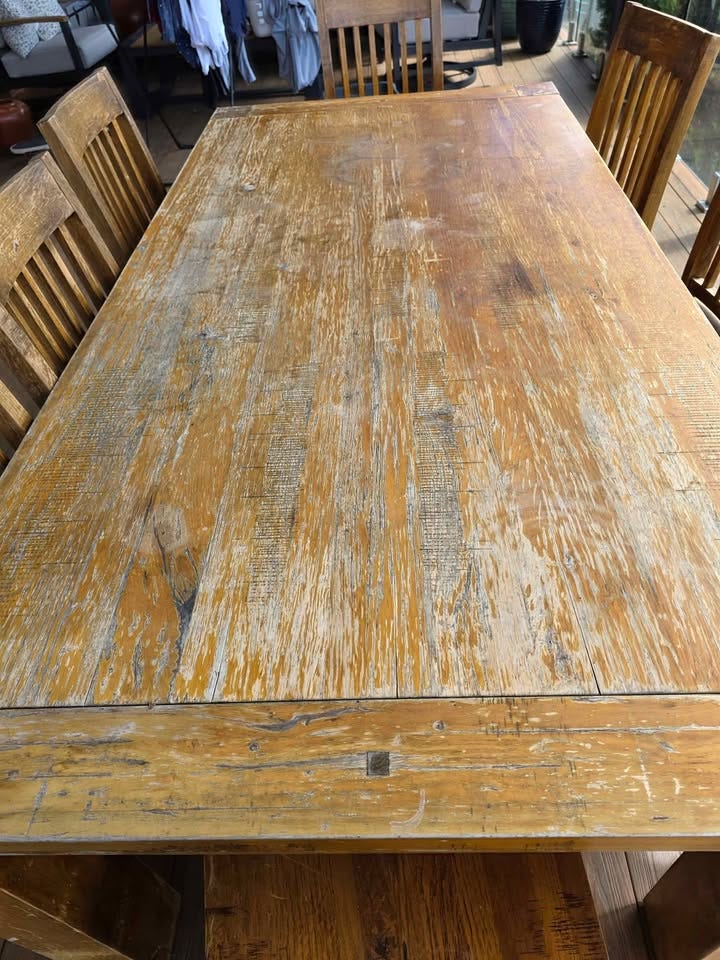For fifteen years, this table was part of our lives. It never quite fit, but we made it work. It was solid—very solid. Reliable. The kind of table you could count on, even if it wasn’t exactly what we needed.
Eventually, it moved outside. It became weathered and rough around the edges, but still, it served a purpose. We ate a few dinners around it. We played makeshift games of table tennis. We told ourselves we’d restore it someday.
But deep down, we knew.
We had outgrown it. It no longer suited our space or our needs. And as much as we appreciated the memories, keeping it around was more about sentiment than practicality.
So, we let it go.
Within an hour of listing it online, someone was eager to pick it up. Someone else had a use for it. And in its absence, we saw something we hadn’t realised what we always wanted and needed: space.
And isn’t that how it is with so many things in life?
The Weight of Holding On
We all do it—hold onto things, routines, and relationships long past their usefulness. The attachment is understandable. Letting go can feel like giving up, like erasing part of our past.
But holding on out of habit can also be a quiet burden, one we don’t notice until it’s lifted.
In our professional lives, this shows up as:
Old projects that no longer align with our goals, yet we keep investing time in them.
Roles that feel safe but don’t challenge us to grow or evolve.
Processes that were once useful but now create inefficiencies we just accept.
Work relationships we maintain out of obligation, even when they no longer inspire or support us.
The hardest part of letting go isn’t knowing what to release—it’s convincing ourselves that it’s okay to move on.
Decluttering for Growth
Letting go isn’t about discarding things randomly. It’s about making intentional choices to create space for what actually serves us.
In the Workplace
Improved Productivity
A cluttered workspace—physically or mentally—drains time and energy.
A never-ending email inbox, old reports, and unnecessary paperwork create distractions.
Outdated software, convoluted approval processes, or redundant meetings slow us down.
Takeaway: Audit your workflow. Ask, Is this necessary? Does this add value? If not, streamline it.
Enhanced Creativity
When we make space, new ideas emerge. But when our workspaces, calendars, and minds are overloaded, there’s no room for fresh thinking.
Teams stuck in rigid structures rarely innovate.
Workplaces with outdated norms struggle to adapt.
Takeaway: Schedule a quarterly "declutter session" for your team. Identify processes, tasks, or tools that no longer serve a purpose.
Emotional Well-being
Work is more than just tasks—it’s about people. A cluttered environment often leads to an overloaded mind.
A chaotic inbox or a disorganised project list creates unnecessary stress.
The pressure of maintaining “business as usual” stops us from embracing better ways of working.
Takeaway: Try a digital detox—clear out old emails, files, and notifications. Set boundaries for information overload.
Better Time Management
How much time do we waste searching for documents, attending unnecessary meetings, or fixing outdated processes?
A lack of organisation steals hours we could spend on meaningful work.
Overloaded schedules prevent deep focus.
Takeaway: Implement the 80/20 rule—identify the 20% of tasks that produce 80% of the impact. Prioritise those.
At Home
Mental Clarity
We often underestimate how much our physical surroundings affect our mental state.
Holding onto things “just in case” creates subconscious stress.
Unused spaces filled with clutter feel stagnant and uninviting.
Takeaway: If you haven’t used something in over a year, ask yourself: Does this add value? If not, let it go.
Stronger Family Dynamics
A home filled with clutter—both physical and emotional—can create underlying tension.
Too many things = distractions from meaningful interactions.
An overstuffed schedule = less time for family connections.
Takeaway: Decluttering isn’t just about things; it’s about priorities. Make space for what truly matters—shared meals, conversations, and quality time.
Adaptability and Growth
Families evolve. Needs change. Yet, we resist letting go because we associate things with memories.
A childhood toy collection may feel sentimental, but does it still belong?
That rarely-used guest room could become a space that actually enhances your life now.
Takeaway: Reimagine your space based on your current needs, not just past ones.
Making Space for What Matters
The hardest part of letting go isn’t knowing what to release—it’s having the courage to actually do it.
Letting go of an old table created space for something better.
Letting go of unnecessary work clutter creates focus.
Letting go of outdated habits, roles, or expectations creates growth.
Holding onto things out of habit can keep us stuck in place. Letting go isn’t about loss—it’s about making space for clarity, creativity, and a future that aligns with who we are now.
And in that space, we find what we truly need.


